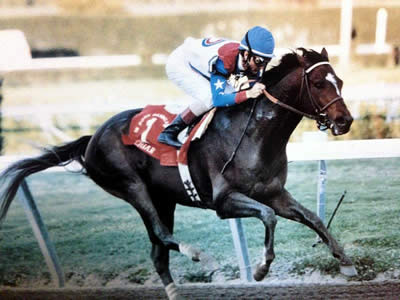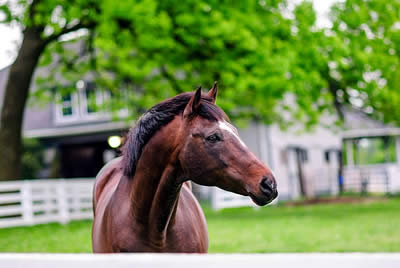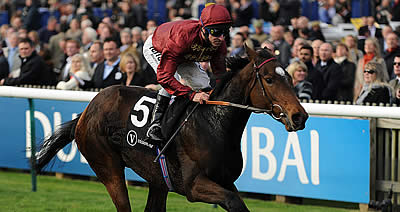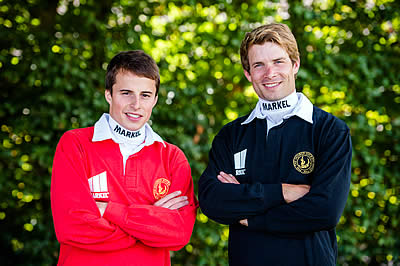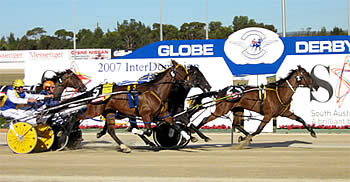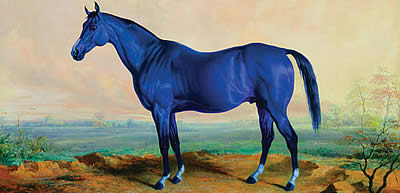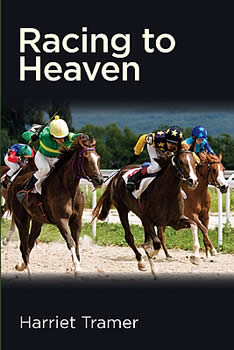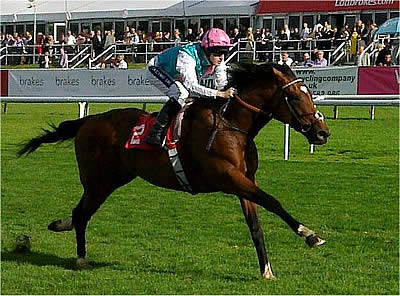Dear Friends,
It is with a heavy heart that we say goodbye to a special part of our family. World champion and legendary racehorse, Cigar, had his final ride to the Rainbow Bridge yesterday. His impressive career included two-time Horse of the Year, a 16 race winning streak, and being inducted into the Racing Hall of Fame.
Besides all of his wins, it was the relationship that we had with Cigar that enriched our lives. He was so full of character, extremely intelligent, and had command presence. He loved being in the limelight and loved what he did. He truly loved to race. My late husband, Allen Paulson, and I had the ride of a lifetime with Cigar.
He lived the last several years in retirement at the Kentucky Horse Park where his adoring fans could meet him in person. We thank everyone who have watched him race and have sent your condolences and stories to us. We are sad to lose our friend, but we couldn’t be more proud of the 24 years we had with him. A big thank you to Steve Haskin for the beautiful tribute that he wrote. Ride on into the sunset, Cigar!
Sincerely,
Madeleine Pickens
———
Haskin: Farewell to Cigar
By: Steve Haskin
October 8, 2014
Racing lost one its all-time greats with the passing of Cigar. As a tribute, I am reprinting some of my most memorable experiences with this magnificent horse.
Garden Party
During a Blood-Horse online chat about five years ago, someone asked me what was my most special moment in racing? Well, needless to say, there are dozens to choose from. But one that ranks right up there at the top did not even occur at a racetrack — or a training center or a breeding farm. It occurred at, of all places, Madison Square Garden.
Shortly after Cigar’s retirement, Madeleine Paulson announced that Cigar would be honored and paraded at the National Horse Show at the Garden on Nov. 2, 1996. She had a close association with the Equestrian world and wanted to show Cigar off to her “horsey” friends and to a whole new audience.
No one knew how they were going to react, not being followers of Thoroughbred racing. But they were horse lovers first and foremost. Mott was not exactly enamored with the idea of vanning Cigar into the heart of Manhattan, and for good reason. It surely had never been done before and the thought of bringing a champion racehorse into this strange environment with masses of people, taxi cabs, and blaring horns seemed absurd. Most everyone else was skeptical to say the least. But Madeleine was determined to pull it off and actually arranged for Cigar to have a police escort and for Seventh Avenue to be closed to traffic for approximately 20 blocks.
Madison Square Garden went all out to pull this off. They invited comedian Bill Cosby, members of the New York Rangers and Knicks, and brought in the Knicks’ cheerleaders and the Budweiser Clydesdales to lead Cigar’s van through the streets of the city to the Garden.
Cigar traveled from Belmont Park to Manhattan in a full-sized van, with a huge color mural on both sides depicting the horse in action. Next to the mural in large blue print with white stars was the name “Cigar.” Above it against a red background were the words “Champion and Horse of the Year,” and below it, “America’s Racehorse.”
The van met up with the Knicks cheerleaders, the Clydesdales, and other participants on a quiet side street several blocks from the Garden. There, the proceedings were organized by MSG officials. Lining the street were a number of fans, several holding posters and banners. One of the posters read: “To the Great Cigar. Thanks for the Memories.” Outside the Garden, groups of school children gathered, waiting to get a glimpse of the great Cigar.
Inside the arena, more than 16,000 people awaited Cigar’s entrance prior to the Horse Show, having no idea what to expect.
By now, Seventh Avenue was closed, and it was an eerie sight looking down one of New York City’s busiest avenues and seeing nothing, not a single car in both directions. When everyone was organized the Cigar parade commenced. With bagpipers, the Knicks cheerleaders, the New York City Mounted Police Corps, and the Clydesdales leading the way, the procession turned down Seventh Avenue to the quizzical looks of passersby, who gawked at the huge, ornately decorated horse van and its odd entourage.
At the Garden, Jerry Bailey posed for photos with the children. Finally, the van arrived and Bailey, decked out in Allen Paulson’s silks, hopped aboard and gave Cigar several reassuring pats on the neck. Looking east on 33rd Street, it was quite a sight seeing the van with the Empire State Building as a backdrop. Cigar peered out at the strange surroundings and then was led into the bowels of America’s most famous arena by Mott and assistant trainer Tim Jones.
At 2 p.m., Bill Cosby came riding in on a horse. After dismounting, he held a microphone directly in front of ringmaster Barry Kiger’s coach horn. As a musical crescendo filled the Garden, the crowd erupted in applause in anticipation of Cigar’s entrance.
When Cigar made his appearance, with Bailey aboard, everyone rose and saluted the champion. Bailey then rose slightly in the saddle, and Cigar, as if on cue, broke into a graceful canter worthy of any champion show horse. The crowd went wild. With Cigar striding majestically around the arena as if part of the Horse Show, the public address announcer bellowed: “Ladies and gentlemen, this is Cigar!”
Bailey then brought Cigar to the middle of the arena, where he was draped in a blanket of red, white, and blue flowers and then presented with baskets of carrots and apples by members of the Rangers and Knicks, including Hall of Fame Ranger Rod Gilbert. After the speeches, Bailey dismounted and Cigar was led around the arena by Mott, as a flurry of flashbulbs popped all around the Garden.
Mott turned the horse over to Jones, who continued to lead him around. Then the lights in the arena went dark, and a single spotlight shone down on Cigar. When a solitary trumpet began playing “Auld Lang Syne,” I have to admit I lost it. Soon after, the entire band joined in, adding to the emotional impact and ending the proceedings with a flourish. Standing on the floor of the arena in the dark, I tried to wipe away the tears before the lights came back on. When they did, I turned around, and almost everyone in the seats was wiping their eyes. That was the single most emotional moment I’ve ever experienced in racing, perhaps in part because Cigar, those closest to him, and myself, were so far removed from the world of racing that the moment transcended the sport and seemed surreal.
Afterward, Jones said, “It was all I could do not to break down. The whole experience brought me to tears. I really believe he knew what was going on and he put on quite a show for everyone. When they played that song it was a joyous moment. But it was also very sad because I knew this was really the end.”
A night in Dubai
It was Jones who had accompanied Cigar to Dubai and supervised his early training for the inaugural Dubai World Cup. I was there providing lead coverage of the event for the Daily Racing Form. The Maktoums put on a show that was unlike anything ever seen before, from the outrageous party in the desert to the raucous rock concert to the dazzling pre-race festivities. On race night, a salmon pink and golden sunset, combined with the floodlights from Nad al Sheba, illuminated the ornate mosques off in the distance, making them sparkle in the twilight. To a Westerner, it was a scene right out of Disney’s Magic Kingdom.
What no one realized was that shortly before the World Cup, word spread quickly throughout the media tent that Cigar was going to be scratched due to a foot problem. Everyone waited for the official word, but it never came. It was only when the horses began walking to the paddock from the barn area and I looked through my binoculars and saw Cigar that the rumor was officially quashed.
I watched the race at the top of the small grandstand with Ray Paulick, then the editor of the Blood-Horse. When Cigar battled back in deep stretch after appearing to be beaten to win by a half-length over fellow American Soul of the Matter, Ray and I jumped up and down like school kids and hugged each other, and then tore through the crowd down to the winner’s circle. Needless to say, that was another surreal moment provided by Cigar, one that no one had ever experienced before. Cigar had come to Dubai and conquered, thus assuring the success of the Dubai World Cup.
Jet setting
But it was earlier that year at the 1996 Eclipse Awards dinner at the Hotel Del Coronado, just across San Diego Bay, that I really became close to Cigar. Not only was I assigned to cover the event, I was also flying from San Diego to Fort Lauderdale that same night on Allen Paulson’s Gulfstream 4 jet, which at the time held the speed record for traveling around the world. The following day, Cigar was scheduled to make his 6-year-old debut in the Donn Handicap.
The other passengers were Allen and Madeleine Paulson, Madeleine’s beloved Jack Russell terrier Oliver, Bill and Tina Mott, Jerry and Suzee Bailey, and my DRF colleague, the legendary Joe Hirsch. My first thought was, if the plane went down I’d be a mere footnote at the bottom of the story.
Normally, Paulson would fly the plane himself, but because of the overnight flight, scheduled to arrive in Fort Lauderdale at about 5:30 a.m. and the big day ahead, he decided to hire a crew and go as a passenger. After boarding the plane, Paulson undid his suspenders, rolled up his sleeves, and took a seat in the front row. Soon after takeoff, Madeleine, reverting to her days as a flight attendant for Pan Am, took drink orders and put out plates of cakes and pastries and platters of food.
Mott and Bailey sat up front handicapping the Saturday card. Mott turned to me and said, “Well, what do you think, Steve? This is a tough assignment, but I guess somebody’s gotta do it.”
About 100 miles west of Tampa, the plane was scheduled to fly over Checkpoint Cigar, for which the horse was named. “Do you want to go up to the cockpit when we fly over it?” Madeleine asked me. “You can go up there anytime you want.”
After beginning to doze off, I looked up through half-closed eyes to see Madeleine covering me with a blanket, bless her heart.
When I awoke, the lights were off and everyone was asleep. Although Cigar would be a heavy favorite in the Donn, Mott was cautiously optimistic. Here he was going to Cigar’s debut and having to stare at the Horse of the Year Eclipse Award trophy that was sitting right in front of him. “I don’t like this scenario of getting all these Eclipse Awards, and everyone is happy, and then, all of a sudden it’s D-Day again in less than 24 hours,” he said earlier. “We’re setting ourselves up for a bunch of long faces.”
At 4:20 a.m., Paulson began to stir. He walked to the back of the plane and told me were getting close to Checkpoint Cigar. About 55 miles from Sarasota I made my way to the cockpit, having to gingerly step over Oliver. The view of the Florida coastline was magnificent, as if we were in a simulator. Although the lights kept getting closer it seemed as if we weren’t moving. “Isn’t that beautiful?” the pilot asked. “It’s like a big video screen. We’re flying 80% the speed of sound, but this plane flies faster than this.”
We quickly passed over the darkness of the Everglades and descended on the lights of Eastern Florida. The landing was smooth as silk, and after the plane came to a halt, Paulson got up, put his suspenders back on, rolled down his sleeves, and said to Mott, “Ready to go to work, Bill?”
Several yards from the plane, Paulson’s limo was waiting to take us all to our respective hotels. As I stepped down from the plane, Paulson reminded me, “Well, you just flew in the fastest plane in the world.”
It was only appropriate, because later that day I’d be watching the fastest horse in the world.
Back home
One of my fondest memories of Cigar was the day he arrived at Belmont Park following his historic victory in the inaugural Dubai World Cup. He hadn’t felt a cool breeze in his face in four months, having been in Florida and then Dubai. Now he was back home, walking up Secretariat Avenue, passing rows of trees and grassy paddocks, and hearing the occasional crowing of a rooster and the chirping of sparrows, as a brisk April wind ruffled his mane.
Judging from the way he pulled assistant trainer Simon Bray and groom Seth Gregory while returning to his old home, Barn 25, after 36 hours in quarantine, there was no doubt he was happy to be back in familiar surroundings.
Although he had lost a little weight and a bit of shine to his coat, it didn’t seem as if the long trip to Dubai, the hot, humid days in the desert, and his gut-wrenching victory in the Dubai World Cup took too much out of him.
Leaving the quarantine barn, Cigar continually gnawed away on his lip chain. The farther he walked the more on the muscle he became, bouncing along on his toes and trying to prop on occasion. This was the first blast of cool air to hit him in months and he was loving every minute of it.
“Man, this horse is pumped; he’s really pulling on me,” Bray said.
As they turned down one of the horse paths, a van blocked the way and Bray and Gregory had to walk Cigar in circles until the van driver could be located. He finally emerged from a nearby barn, and as he got into his van, a truck pulled alongside. The driver of the truck opened the window and shouted to the van driver: “You gotta move that van for the mighty Ceeegar, the greatest horse of all time.”
When Cigar arrived at Mott’s barn, he was reluctant to go in his stall, balking several times. That was the last place he wanted to be, but finally he gave in. “There you go, buddy, back in stall 3,” Bray said to him as he removed his lip chain and gave him a friendly whack on the rear end.
Once free, Cigar let it all out, rolling several times in the straw, grunting and squealing. After getting up and pawing at the ground, he charged the webbing and thrust his head out the stall door, scattering whoever was standing nearby.
As Bray and Gregory returned to the quarantine barn to get Cigar’s pony, Snowball, who had gained fame himself while in Dubai, Cigar stood at his stall door with his head up and ears cocked, staring out the barn window and up and down the shed with that familiar white eye.
“You got your favorite window and your favorite stall back,” said day watchman Jimmy Camic. “I’m just glad he’s back safe, thank God. I’ll sit here with a two-by-four if I have to, and God forbid if any s.o.b. gives me a hard time.”
Soon, Gregory’s parents and brother arrived at the barn to take their son back to a hero’s welcome in their hometown of Garrattsville, N.Y., 16 miles from Cooperstown. Gregory had accompanied Cigar to Dubai when the horse’s regular groom, Juan Campuzano, was unable to get his visa processed in time.
“Seth, the guys at the pharmacy all said to send their congratulations,” Gregory’s mother told him. “I was in there yesterday and they were so excited. They can’t wait to see you.”
“I don’t know why I’m such a hero,” Gregory said. “He did it all.”
But Cigar had a way of making heroes out of all those close to him.
Attention, shoppers
Tom Durkin’s voice bounced off the walls in resounding fashion. “Cigar! Cigar makes his move and he sweeps to the lead with a dramatic rush… the invincible, the incomparable, the unbeatable Cigar.”
This historic call of the 1995 Breeders’ Cup Classic wasn’t being heard at a racetrack or a simulcasting facility or any place even remotely associated with racing. On this occasion, three months after the race, pant legs shook, shirt buttons popped, and ties stiffened at the sound of Durkin’s unforgettable call. You see, the race was being shown in the men’s department at Sears in Lawrenceville, N.J.
Following the race, Cigar’s presence seemed to be everywhere – from department stores, helping to sell team apparel, to Sports Illustrated’s “Sportsman of the Year” issue, to GQ, to Cigar Aficionado magazine, to a full page ad by Macanudo Cigar Co. in the New York Times, which read: “From One Cigar to another. Macanudo salutes the winner of the 1995 Breeders’ Cup Classic on his 12th consecutive victory.” The cost of the ad: $58,000.
The world loves perfection, and in 1995, Cigar was the epitome of perfection, as he traveled some 12 miles of racetrack real estate, covering nearly 10,000 miles by van and plane, while visiting six racetracks in six different states. Whether on fast, wet-fast, or muddy tracks, all Cigar’s rivals saw of him were the black and gray streaks of his tail. Among those inhaling Cigar’s smoke were the winners of the 1995 Kentucky Derby, Belmont, Travers, Santa Anita Handicap, Pacific Classic, Whitney Handicap, and the Juddmonte International and Eclipse Stakes in England, as well as past winners of the Breeders’ Cup Classic, Santa Anita Handicap, Pimlico Special, Hollywood Gold Cup, and Oaklawn Handicap.
And through it all, Bill Mott was the perfect host, granting interviews to anyone who asked and handling everything with class. He even put my then 12-year-old daughter up on his pony and led her around the shedrow and outside the barn. While the entire Cigar experience and the 16-race winning streak would have stressed out many trainers, Mott might as well have been sitting on a rocking chair back in Mobridge, South Dakota whittling away on a piece of hickory. If ever a horse and trainer fit each other it was Cigar and Mott.
Saying goodbye
It was Cigar’s final race, and the script called for him to go out a winner in the 1996 Breeders’ Cup Classic. But a nose and a head separated him from the storybook ending. The sun had just begun to descend behind Woodbine’s clubhouse turn as Cigar walked off the track for the last time. Shafts of light beamed down on him from an amber sky, creating a setting that was meant for a triumphant farewell. But Cigar’s weary legs and cracked feet, that had carried him some 25,000 miles across the United States and to Dubai, could not carry him those final few inches.
Back at the barn, Cigar stood facing the back of his stall, as if he knew he had lost. Allen and Madeleine Paulson stopped by for a final visit before heading off to dinner, but Mott remained. For several minutes, he stared almost hypnotically into Cigar’s stall. When he spoke, his voice couldn’t hide the emotions that were obviously building up inside him. This was no time to be dwelling on defeats or having any regrets that Cigar’s career did not end in triumph. The only images Mott was seeing as he stared into the stall were of cheering crowds and magnificent victories.
“There’s nothing I can say about Cigar that can tell you how I feel about him and the whole experience,” Mott said in a quiet monotone voice. “There’s no reason that getting beat a short head would make me feel any differently about him. I’d be pretty damn greedy if I did or if I had any ill feelings about anything. When we decided to run him again this year I knew as a trainer that trying to have a repeat year was going to be a tough task come Breeders’ Cup time. He just lost that little step, that little turn of foot, and that’s been the difference. Before, he could have overcome having to go five-wide. Today, he just couldn’t… he couldn’t overcome it.”
Just then, 82-year-old Georgia Ridder, owner of the victorious Alphabet Soup, came over to Mott, who congratulated her.
She replied, “Congratulations on the greatest horse of many years. It was just our luck today.”
“Well, you had a good day and I’m happy for you,” Mott said. “I hope you have many many more.”
So ended the remarkable career of Cigar. In For Whom the Bell Tolls, Ernest Hemingway wrote: “But did thee feel the earth move?”
Cigar’s greatness was felt as much as it was seen. Just ask anyone who was there when Cigar rocked the grandstands at Arlington Park, Suffolk Downs, and Belmont Park. Just ask anyone who was there when Cigar made the sands of Dubai shake. Just ask anyone who was there when Cigar jolted the hallowed walls of Madison Square Garden.
Although Cigar’s accomplishments and statistics speak of greatness, they are just one aspect of his legacy. He took the torch passed to him by Holy Bull and made thousands of new racing fans around the world. He made believers out of skeptics. He made poets and artists out of 7-year-olds and 70-year-olds. He made people cheer and he made people cry.
But most of all, he made the earth move.
Read more on BloodHorse.com: http://cs.bloodhorse.com/blogs/horse-racing-steve-haskin/archive/2014/10/08/haskin-farewell-to-cigar.aspx#ixzz3FaAokkQc
Saving America’s Mustangs | 2683 Via De La Valle, G 313 | Del Mar | CA | 92014
